By Mike Rainone for the News
From the beginning of the 19th century rows upon rows of majestic wooden grain elevators began popping up on the railway sidings of busy new hamlets, villages, and towns across the rugged prairies of western Canada.
For close to a century these massive structures would be proudly referred to as Prairie icons, cathedrals, and sentinels, and had become a powerful visual symbol and declaration of each and every community’s economic viability and ongoing agriculture strength and success. Earliest activity in this regard occurred in the late 1800s when the Canadian Northern, Grand Trunk, and C and E (later CPR) Railways began negotiations with communities to build elevators along their lines, which would assure the rapid transportation of grain products from coast to coast.
The very first elevator in Canada was constructed in 1879 by William Hespeler at Niverville, Manitoba with the sole purpose of weighing and storing the vital grain crops of the hardy and brave pioneer families who were establishing new homesteads and seeking future opportunity and success on the Prairies. Those earliest standard elevators had a storage capacity of 25,000 bushels, with the first founding elevator companies and flour mills erecting their facilities to serve the sudden urgent needs of thousands of customers in the booming agriculture community. This flurry of construction and demand for services would result in 5,800 elevators in operation in Canada by 1933 and growing at a rapid pace.
The colourful history of Ponoka elevators
Around the time that Ponoka officially became a town in 1904 Messrs. Alexander and Tugman were running an operation that included a mill and grain elevator as well as coal and machine sheds at the north end of 50th street. Messrs. Canfield, McIntyre, and Albrecht likely had the first feed mills in the same area, but were rapidly followed by such energetic and colourful community entrepreneurs as Taylor and Peterson, Sam Scott, Andy Low, Mr. Waldern, Dave Park, Bill Jones, George Gage, Ray Henry, Jimmy Vold, Harry Ravnsborg, and on and on.
Ponoka’s very first company owned and operated grain elevator was established in 1906 when Pioneer Grain took over the original facility of Alexander and Tugman, which burnt down in 1909 but was rebuilt by the local veterinarian Dr. Pullyblank, who also became the agent. By 1915 ‘elevator row’ began to grow with the addition of Wetaskiwin Produce and Alberta Pacific, and was followed in 1925 and 1926 by Midland Grain Company, Alberta Pacific Grain Company, Pioneer Grain Company, Federal Grain Company, The Alberta Wheat Pool, and other farming co-operatives. Other congenial local grain agents over the years included: A.E. Hobbs, Norman McLeod, Ted Murray, Cecil Bieber, Chris Schmidt, George Coote, Sam Scott, Marvin Carter, Millar Huston, Jack Thumlert, and so many others on into the future.
It was always a very busy and colourful community day-to-day event when the district farmers ‘came to town’ with their grain, milk, stock, families, and all the rest. They always had to pack their precious crops into bags before leaving home because the wagon boxes were not tight enough to hold the loose grain, and once the agent dumped the bags into the bin a gasoline engine powered the belt that would elevate the grain up for storage for later transfer into the grain cars on the Ponoka CPR siding.
After dropping his wife and the children off at the local ladies’ restroom on 51st Avenue the farmer would go about his business at the elevator, livery stable, or other stops around town, and then may just find a little time to tie up the horses along Chipman Avenue and pop into the pool hall for a game or to the Leland or the Royal taverns for a visit and a pint with friends and neighbours. On many occasions the whole family would stay a little later to take in an auction, rodeo, concert or a movie at the Empress Theatre, or a hockey or a baseball game, and then it would be time to bundle up for the long trip home. In the beginning the grain elevators were located at seven-mile intervals to enable the farmers to haul their grain home and return on the same day, but later when the era of the automobile arrived the trip was much easier and the load a lot bigger.
History tells us that at one time there were 10 elevators in operation at Ponoka, but over the years several disastrous fires took their toll, many were not replaced, and as the grain companies began to change their business plans only six would remain along Railway Street by 1999. At that time there was an increasing reliance on truck transportation and construction had begun on the newly designed massive cement and steel storage terminals that would hold up to 175,000 bushels of grain and would serve their customers on a more wide-spread regional basis. Those traditional early wooden grain elevators proudly served the prairies for close to a century, but slowly began to disappear from the western landscape, with only a few being saved and moved to serve for promotional purposes or other uses, as well as being forever honoured and admired at such historical sites as the Prairie Elevator Museum and Tea House at Acadia Valley, Alberta.
There is no doubt that the ‘golden age of grain elevators’ has now past, that those ominous, dusty, but magnificent structures that filled our prairie skylines for countless decades have now gone forever, but will never be forgotten as the early economic backbone of so many thriving communities, as well as a most vital service and icon of friendship for many thousands of hardy farmers here, and throughout our great province and nation.
